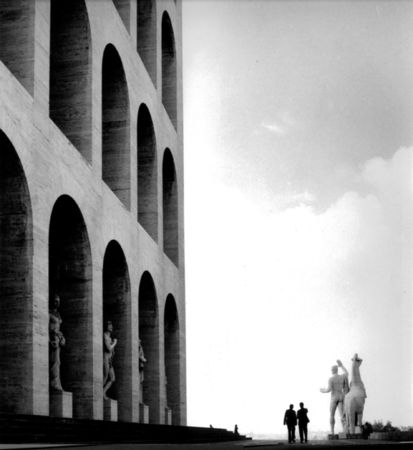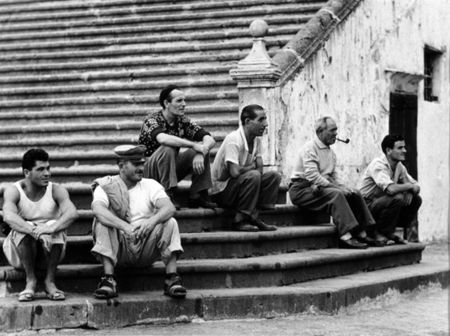A series of exhibitions organized at Villa Manin di Passariano, in Casarsa della Delizia and in Pordenone celebrates Elio Ciol
UDINE, ITALY.- A series of exhibitions organized at Villa Manin di Passariano, in Casarsa della Delizia and in Pordenone celebrates the eighty years of Elio Ciol, one of the Italian landscape photographers better known in the world, and sixty years of professional work of the artist. Elio Ciol is known mainly for his photographic interpretations of Italian landscape and for his work of documentation of artistic heritage. The Villa Manin exhibition deals with a lesser known period of the photographer, that of the years of his formation, between 1950 and 1964. The exhibition is made of 140 photographs, many of which never previously shown, and is held in a lateral building of Villa Manin, the great country palace near Codroipo that has been one of the major exhibition sites of Friuli Venezia Giulia county for many years
Italy was living at the time a period of great creative ardour in all fields, from cinema to literature, from arts to photography. The country had just come out of the war, and in the developed areas was in the middle of the great work of industrial transformation. The climax of neorealism brought innovative sights on this society in transformation with messages that penetrated deeply in the population thanks to the diffusion of cinema and printed press.
Elio Ciol, making his debut, participated to the debate in those years, for example attending to the club La Gondola in Venice, that in those years was a focal point of photographic creativity. He also narrated with his images the fervent climate of social transformation, but also the seeming stillness of the countryside and the mountains in Friuli and Veneto, that in that period were still living in ancient ways of life and production; and also the enchantment of Southern Italy, very similar to what fascinated the travelers of Grand Tour in 18th century. Elio Ciol’s narration showed also the signs of a refined language, built through a formal research hooked to black and white. Life and aesthetics blend in the images of the period, and the proof is in the extraordinary photographs Ciol shot a few hours after the Vajont tragedy.
The work as stage photographer for the film Gli Ultimi written by David Maria Turoldo and directed in 1972 by Vito Pandolfi deserves particular attention. Turoldo built an elelegy of the values of traditional country life which is more important to us now then when the film was produced (it was a huge commercial disaster). The photographs of Ciol are a “story within the story” they show moments of the backstage, expressions of actors and film crew, but they also show that Friuli landscape that was already part of his view.
The exhibition shows also other moments that seem to come from a distant past. Visions of Venice, of Assisi, of the countryside around Milan, moments of the mountain life, realities that in a few years were going to be transformed by modernity. The gaze of Ciol was also slowly transforming itself, creating the fine art philosophy that emerged even when his lens framed people, sights, expressions.
Elio Ciol
Elio Ciol was born at Casarsa della Delizia (Pn) where he still lives and works. He began working in his father’s photography studio at an early age. He acquired substantial technical experience and developed his own way of interpreting works of art and expressing himself in photography, outstandingly in the landscape.
Ever seeking new techniques and new forms of pictorial communication, he was a member of the Udine film club from 1955 to 1965. He made several documentaries, taking his time, winning awards in the Concorso Nazionale del Cineamatore of Montecatini and the Concorso Internazionale del Cineamatore of Salerno.
From 1955 to 1960 he was a member of the “La Gondola” photography club in Venice. In 1962 he was the official set photographer during the shooting of the film Gli ultimi by Vito Pandolfi and Father David Maria Turoldo.
In 1963 in Milan he collaborated with Luigi Crocenzi in founding the “Arnaldo and Fernando Altimani Foundation for the study and experimentation of all forms of pictorial communication”. The same year at the Ambrosianeum in Milan he exhibited the photographs of his report on the activity of “Gioventù Studentesca” in the Lower Milanese.
A great many photography exhibitions in Italy and abroad. Two highly significant retrospectives: in 1999 organised by the Civici Musei and the Municipality of Udine in the grandiose exhibition space of the Church of San Francesco and in 2002 sponsored by the Municipality of Padua in the Palazzo del Monte di Pietà.
He received prizes and awards, including, to quote only the most recent: 1991, Citizen of the Year; 1992, London, Kraszna Krausz Prize for the photography book Assisi, shared with books by Sebastião Salgado, Paul Strand and Irving Penn; 1993, Pordenone, San Marco Award; 1995, Spilimbergo, CRAF Friuli-Venezia Giulia Special Prize for Photography; 1996, London, Kraszna Krausz Prize for the photography book Venezia, shared with books by R. Doisneau, E. Hartmann and N. Rosenblum; 1997, Amsterdam, World Press Photo, Third Prize in the category “Nature and Environment”; 1999, Buia, Nadal Furlan Award 1999, XXI year;2001, Padua, “Dietro l’obiettivo: una vita”, Foto Padova 2001; 2003, Padua, “Premio Foto Padova 2003 per il migliore fotolibro”, Ascoltare la luce.
His photographs are in the collections of the following museums: Metropolitan Museum of Art, New York; International Museum of Photography, Rochester, New York; Center for Creative Photography Tucson, Arizona; Humanities Research Center, University of Texas, Austin; The Art Museum, Princeton University, New Jersey; Centre Canadien d’Architecture, Montréal, Canada; The Art Institute of Chicago; The University College of Wales, Aberystwyth; Victoria & Albert Museum, London; Musée de la Photographie, Charleroi; Civici Musei e Gallerie di Storia e Arte, Udine; Galleria di Arte Contemporanea Pro Civitate Christiana, Assisi; Museo Diocesano e Gallerie del Tiepolo, Udine; and in many private galleries.
Very beautiful Ciol's photographies at Amador Gallery www.amadorgallery.com
Elio Ciol, ROMA, EUR, 1955, Gelatin silver print. Courtesy Amador Gallery
Elio Ciol, FIRENZE, 1960. Gelatin silver print. Courtesy Amador Gallery
Elio Ciol, COLONNE DEL TEMPIO DI MINERVA 1992. Gelatin silver print. Courtesy Amador Gallery
Elio Ciol, PINZANO 1957. Gelatin silver print. Courtesy Amador Gallery
Elio Ciol, ASSISI 1957. Gelatin silver print. Courtesy Amador Gallery
Elio Ciol, GIOVANI A SAN DANIELE 1957. Gelatin silver print. Courtesy Amador Gallery
Elio Ciol, CIMOLAIS 1958. Gelatin silver print. Courtesy Amador Gallery
Elio Ciol, AMALFI 1957. Gelatin silver print. Courtesy Amador Gallery

/https%3A%2F%2Fprofilepics.canalblog.com%2Fprofilepics%2F1%2F0%2F100183.jpg)












/http%3A%2F%2Fp9.storage.canalblog.com%2F92%2F51%2F119589%2F98216442.jpg)
/https%3A%2F%2Fassets.over-blog.com%2Ft%2Fcedistic%2Fcamera.png)
/https%3A%2F%2Fstorage.canalblog.com%2F77%2F60%2F577050%2F66527770_o.jpg)
/https%3A%2F%2Fstorage.canalblog.com%2F91%2F69%2F577050%2F66524735_o.jpg)